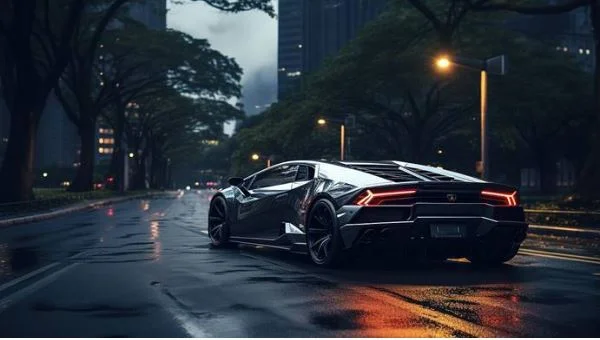The question of ceramic tint vs regular tint is common when selecting the right window tint film for your vehicle, home, or office. Both provide privacy, UV protection, and a sleek appearance, but meaningful performance, cost, and durability differences exist. This post covers the main differences, pros, and cons so you can choose the right tint for you.
What Is Regular Window Tint?
Regular window tint, also known as standard or dyed window film, is the most common and affordable type of window tint. It is a thin layer of ink sandwiched between a bonding layer and a protective overcoating.
Key Features of Regular Tint:
- Cost: This is the cheapest way to tint windows.
- Look: It provides a superb, dark finish that looks great.
- Reduce Sun Glare: Prevents sun glare, helping to see clearly.
- UV Protection: Blocks at least 50% of the sun’s harmful ultraviolet rays.
The only bad thing is that the tint fades, but all regular tints fade and might not protect from heat or clear-view reception.
What Is Ceramic Window Tint?
Ceramic tint is a high-quality film that is constructed using ceramic particles that are both non-metallic and non-conductive. In nearly every aspect, it outperforms metallic or dyed cinema.
Key Features of Ceramic Tint:
- Unmatched Heat Rejection: Reflects up to 80-90% of infrared energy, so you can Say Goodbye to heat.
- Increased UV Protection: Protect your skin with our 99 %+ UV pass-through.
- No Signal Interference: metal-free construction will not interfere with GPS, cell, or radio.
- Durability: Ceramic films do not fade, and long-term clarity is maintained.
- Clear View: This is a good way to see the back, even at night or in low light.
Ceramic tint tends to be more costly than regular tints because of its high-tech nature.
Ceramic Tint vs Regular Tint: Side-by-Side Comparison
| Feature | Regular Tint | Ceramic Tint |
| Cost | Low | High |
| Heat Rejection | Moderate | Excellent |
| UV Protection | Up to 50% | 99%+ |
| Glare Reduction | Good | Excellent |
| Durability | It may fade over time | Long-lasting |
| Signal Interference | May occur (if metallic) | None |
| Appearance | Good | Superior clarity |
Which Tint Is Best for You?
Your budget and particular requirements will determine whether ceramic or conventional tint is best for you.
Choose Regular Tint If:
- You are on a tight budget.
- Your main priority is to spruce things up and enjoy some privacy.
- You don’t reside in an especially hot part of the country.
Choose Ceramic Tint If:
- You are looking for both the best heat and UV protection.
- You worry about long-term durability.
- You’re using GPS, Bluetooth, or cell services a lot.
- You live in a sunny, warm climate and are looking to cut down on air conditioning bills.
The Long-Term Investment Perspective
Even if ceramic tint is more expensive on the front end, it could save you money in the long run. It also saves heating and cooling costs and maintains your car’s interior value.
Regular tint is cheaper but may need to be replaced more often. It is worse under moderate to heavy sunlight and in extreme environments.
Legal Considerations
Always check your local regulations on window tint before making a decision. In some areas, you are limited in how dark you can go with your windows, independent of the type of film you use.
Ceramic tints are usually available in different colors and can provide legal tinting solutions, but with better protection than normal alternatives.
Installation Matters
However, you decide to tint it, we highly recommend professional installation. Professional installation guarantees a bubble-free application with a flat, non-stick optical transmission gel that will not separate or break down over long-term use.
Conclusion
In conclusion, ceramic is the clear winner in performance, protection, and durability! But it is also more expensive. Standard tinting is still a cost-effective choice for those seeking privacy and security, but don’t mind sacrificing premium quality. Ultimately, the decision will come down to price, functionality, and where you will use the tint.
FAQ’s
Q1: Ceramic Tint Worth the Cost or Not?
A: Yes, if you want a premium product with excellent heat rejection, signal clarity, and long-term quality. It gives better all-around performance in hot conditions or with expensive vehicles.
Q2: Does the ceramic tint block my phone or GPS signal?
A: No, ceramic tint is completely non-metallic and does not block electronic signals, unlike some metallic or hybrid films.
Q3: What is the lifespan of standard window tint?
A: Regular window tint lasts 3 to 5 years, depending on sunlight exposure and installation quality.
Q4: Will ceramic tint save us money on energy?
A: Yes, it can cut air conditioning usage by keeping interiors cooler, potentially resulting in noticeable energy savings over the long run.
Q5: Is ceramic tint darker than regular tint?
A: Not necessarily. Ceramic shades can come in a multitude of hues. Lighter ones may block out heat and UV rays than darker regular tints.



